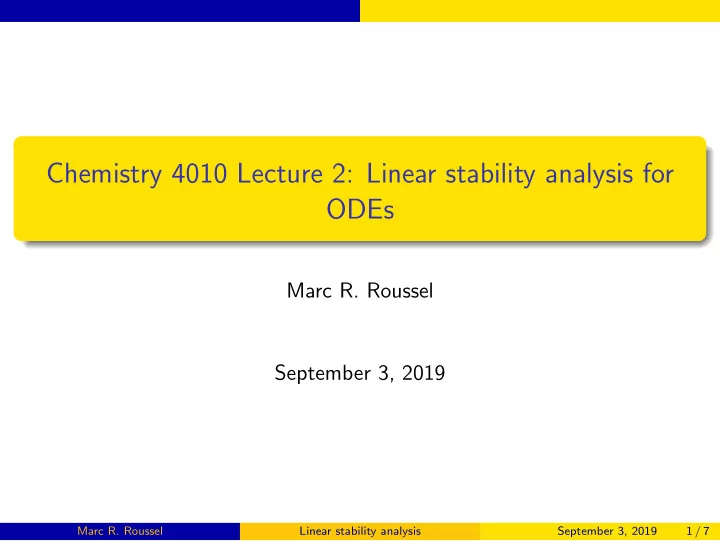

Chemistry 4010 Lecture 2: Linear stability analysis for ODEs Marc R. Roussel September 3, 2019 Marc R. Roussel Linear stability analysis September 3, 2019 1 / 7
Linearizing an ODE Suppose we have a set of ODEs x = f ( x ) ˙ with an equilibrium point x ∗ , i.e. f ( x ∗ ) = 0 . How do the trajectories near x ∗ behave? Taylor expansion of f near x ∗ : ✯ 0 � f ( x ∗ ) + ∂ f ✟ � ( x − x ∗ ) 2 � � x = ✟✟ ˙ x ∗ ( x − x ∗ ) + O � ∂ x � Big O notation: denotes terms with an exponent at least as large, in this case terms with an exponent of at least 2. If x is sufficiently close to x ∗ , then � x ≈ ∂ f � ˙ x ∗ ( x − x ∗ ) � ∂ x � Marc R. Roussel Linear stability analysis September 3, 2019 2 / 7
Linearizing an ODE ∂ f /∂ x is the Jacobian matrix, often denoted J : ∂ f 1 ∂ f 1 ∂ f 1 . . . ∂ x 1 ∂ x 2 ∂ x n ∂ f 2 ∂ f 2 ∂ f 2 . . . ∂ x 1 ∂ x 2 ∂ x n J = . . . . . . . . . . ∂ f n ∂ f n ∂ f n . . . ∂ x 1 ∂ x 2 ∂ x n We need the Jacobian evaluated at x ∗ , which is a constant matrix J ∗ . The linearization becomes x = J ∗ ( x − x ∗ ) ˙ . . . or, if we define δ x = x − x ∗ , δ x = J ∗ δ x ˙ Marc R. Roussel Linear stability analysis September 3, 2019 3 / 7
Linearizing an ODE δ x = J ∗ δ x is a linear ordinary differential equation. ˙ The solution can be written n � a j e j e λ j t δ x = j =1 where ( λ j , e j ) is one of the n eigenvalue-eigenvector pairs of the matrix J ∗ , and the a j are constants chosen to satisfy the initial conditions. Theorem: The equilibrium point x ∗ is locally stable if all of the λ j have negative real parts. It is unstable if at least one of the λ j has a positive real part. Marc R. Roussel Linear stability analysis September 3, 2019 4 / 7
Technical details: eigenvalues of a matrix The eigenvalues λ of a matrix A satisfy the characteristic equation | λ I − A | = 0 The left-hand side of the characteristic equation is a polynomial in λ . If A is an n × n matrix, then the characteristic polynomial has degree n , so there are n eigenvalues. The eigenvalues can be real, or can appear in complex-conjugate pairs λ j , j +1 = µ j ± i ν j . Marc R. Roussel Linear stability analysis September 3, 2019 5 / 7
Technical details: exponentials of complex numbers The solutions of a linear differential equation involve the exponentials of the eigenvalues, e λ j t . If λ j = µ j + i ν j , then e λ j t = e µ j t e i ν j t Euler’s formula allows us to expand the exponential with the imaginary argument: e i ν j t = cos( ν j t ) + i sin( ν j t ) Conclusion: From the point of view of stability, only the real part of the eigenvalue matters. Marc R. Roussel Linear stability analysis September 3, 2019 6 / 7
A quick recap The behavior near the equilibrium point is governed by the differential δ x = J ∗ δ x with solution equation ˙ n � a j e j e λ j t δ x = j =1 The linear stability theorem says the following: The equilibrium point x ∗ is locally stable if all of the λ j have negative real parts. It is unstable if at least one of the λ j has a positive real part. Note that the theorem says nothing about what happens if there are eigenvalues with zero real part, the rest all having negative real parts. Marc R. Roussel Linear stability analysis September 3, 2019 7 / 7
Recommend
More recommend